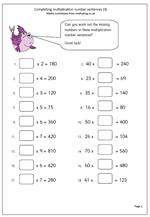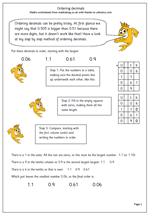 Here is the second in a mini-series of maths worksheets that look at using knowledge of multiplication and tables to complete number sentences.
Here is the second in a mini-series of maths worksheets that look at using knowledge of multiplication and tables to complete number sentences.
Again, the most important aspect of this page is to illicit what processes children use to answer the questions, and it is a worthwhile experience to ask yourself exactly how you went about it in your mind to reach the answer – it is not necessarily the way we would explain to children, yet it could well be a very effective way. Let’s look at a couple of the questions;
Question 3: ? x 4 = 44.
This I can answer without doing any kind of calculation in my head because I know, off by heart, that 4 x 11 = 44.
Question 7: ? x 5 = 110
A harder question which can be tackled several ways. I actually worked from knowing that 20 fives make 100 and then adding two more fives for the ten, making the answer 22. I probably wouldn’t suggest this to children. What I would suggest is double the 110 to make 220 and then divide by ten to make 22 (and explaining why this method works).








